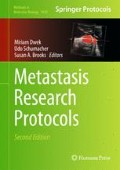Abstract
Invasion of carcinoma cells is the result of a disequilibrium between invasion promoter and invasion suppressor gene products (Mareel and Van Roy, Anticancer Res 6:419–435, 1986). The E-cadherin/catenin complex is the most potent invasion suppressor at the cell membrane of epithelioid cells (Duffy et al., J Pathol 214:283–293, 2008). This complex consists of E-cadherin, a transmembrane glycoprotein of 120 kDa, which is linked to the actin cytoskeleton via the catenins (Behrens et al., J Cell Biol 108:2435–2447, 1989). Downregulation of the complex is a common feature in invasive carcinoma cells, and has been recognized at several levels, ranging from genomic mutations to functional deficiencies of an apparently intact complex (Ozawa et al., Proc Natl Acad Sci USA 87:4246–4250, 1990). Cell aggregation assays have been set up to test the functionality of the complex in epithelioid tumor cells. Functional integrity of the complex is a prerequisite for cell–cell adhesion between epithelial cells, and measuring cell aggregation in vitro has thus become another elegant tool to study differences between invasive and noninvasive cell types.
Access this chapter
Tax calculation will be finalised at checkout
Purchases are for personal use only
References
Mareel MM, Van Roy FM (1986) Are oncogenes involved in invasion and metastasis? Anticancer Res 6:419–435
Duffy MJ, McGowan PM, Gallagher WM (2008) Cancer invasion and metastasis: changing views. J Pathol 214:283–293
Behrens J, Mareel MM, Van Roy FM, Birchmeier W (1989) Dissecting tumour cell invasion: epithelial cells acquire invasive properties after the loss of uvomorulin-mediated cell–cell adhesion. J Cell Biol 108:2435–2447
Ozawa M, Ringwald M, Kemler R (1990) Uvomorulin–catenin complex formation is regulated by a specific domain in the cytoplasmic region of the cell adhesion molecule. Proc Natl Acad Sci USA 87:4246–4250
Van Aken E, De Wever O, Correia da Rocha AS, Mareel M (2001) Defective E-cadherin/catenin complexes in human cancer. Virchows Arch 439:725–751
Bracke ME, Vyncke BM, Bruyneel EA, Vermeulen SJ, De Bruyne GK, Van Larebeke NA, Vleminckx K, Van Roy FM, Mareel MM (1993) Insulin-like growth factor I activates the invasion suppressor function of E-cadherin in MCF-7 human mammary carcinoma cells in vitro. Br J Cancer 68:282–289
Noe V, Willems J, Vandekerckhove J, Roy FV, Bruyneel E, Mareel M (1999) Inhibition of adhesion and induction of epithelial cell invasion by HAV-containing E-cadherin-specific peptides. J Cell Sci 112:127–135
Kadmon G, Kowitz A, Altevogt P, Schachner M (1990) The neural cell adhesion molecule N-CAM enhances L1-dependent cell–cell interactions. J Cell Biol 110:193–208
Beuthan J, Minet O, Helfmann J, Herrig M, Muller G (1996) The spatial variation of the refractive index in biological cells. Phys Med Biol 41:369–382
Young IT (1977) Proof without prejudice: use of the Kolmogorov-Smirnov test for the analysis of histograms from flow systems and other sources. J Histochem Cytochem 25:935–941
Vermeulen SJ, Bruyneel EA, Van Roy FM, Mareel MM, Bracke ME (1995) Activation of the E-cadherin/catenin complex in human MCF-7 breast cancer cells by all-trans-retinoic acid. Br J Cancer 72:1447–1453
Vermeulen SJ, Nollet F, Teugels E, Vennekens KM, Malfait F, Philippe J, Speleman F, Bracke ME, Van Roy FM, Mareel MM (1999) The alphaE-catenin gene (CTNNA1) acts as an invasion-suppressor gene in human colon cancer cells. Oncogene 18:905–915
Bracke ME, Van Larebeke NA, Vyncke BM, Mareel MM (1991) Retinoic acid modulates both invasion and plasma membrane ruffling of MCF-7 human mammary carcinoma cells in vitro. Br J Cancer 63:867–872
Bracke ME, Charlier C, Bruyneel EA, Labit C, Mareel MM, Castronovo V (1994) Tamoxifen restores the E-cadherin function in human breast cancer MCF-7/6 cells and suppresses their invasive phenotype. Cancer Res 54:4607–4609
Charlier C, Bruyneel E, Lechanteur C, Bracke M, Mareel M, Castronovo V (1996) Enhancement of tamoxifen-induced E-cadherin function by Ca2+ channel antagonists in human breast cancer MCF7/6 cells. Eur J Pharmacol 317:413–416
Bracke ME, Bruyneel EA, Vermeulen SJ, Vennekens K, Van Marck V, Mareel MM (1994) Citrus flavonoid effect on tumour invasion and metastasis. Food Technol 48:121–124
Van Marck V, Stove C, Van Den Bossche K, Stove V, Paredes J, Vander HY, Bracke M (2005) P-cadherin promotes cell–cell adhesion and counteracts invasion in human melanoma. Cancer Res 65:8774–8783
Koutsouki E, Beeching CA, Slater SC, Blaschuk OW, Sala-Newby GB, George SJ (2005) N-cadherin-dependent cell–cell contacts promote human saphenous vein smooth muscle cell survival. Arterioscler Thromb Vasc Biol 25:982–988
Canonici A, Steelant W, Rigot V, Khomitch-Baud A, Boutaghou-Cherid H, Bruyneel E, Van RF, Garrouste F, Pommier G, Andre F (2008) Insulin-like growth factor-I receptor, E-cadherin and alpha v integrin form a dynamic complex under the control of alpha-catenin. Int J Cancer 122:572–582
Debruyne D, Mareel M, Vanhoecke B, Bracke M (2009) Cell aggregation on agar as an indicator for cell-matrix adhesion: effects of opioids. In Vitro Cell Dev Biol Anim 45:473–482
Lahaye M, Rochas C (1997) Chemical structure and physico-chemical properties of agar. Hydrobiologia 221:137–148
Author information
Authors and Affiliations
Editor information
Editors and Affiliations
Rights and permissions
Copyright information
© 2014 Springer Science+Business Media, New York
About this protocol
Cite this protocol
Debruyne, D., Boterberg, T., Bracke, M.E. (2014). Cell Aggregation Assays. In: Dwek, M., Schumacher, U., Brooks, S. (eds) Metastasis Research Protocols. Methods in Molecular Biology, vol 1070. Humana Press, New York, NY. https://doi.org/10.1007/978-1-4614-8244-4_6
Download citation
DOI: https://doi.org/10.1007/978-1-4614-8244-4_6
Published:
Publisher Name: Humana Press, New York, NY
Print ISBN: 978-1-4614-8243-7
Online ISBN: 978-1-4614-8244-4
eBook Packages: Springer Protocols

